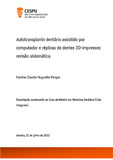| dc.contributor.advisor | PEREIRA, JOÃO PAULO ALVES FONTES | |
| dc.contributor.author | Ifergan, Pauline Claudie Huguette | |
| dc.date.accessioned | 2022-11-07T13:40:06Z | |
| dc.date.available | 2022-11-07T13:40:06Z | |
| dc.date.issued | 2022 | |
| dc.identifier.uri | http://hdl.handle.net/20.500.11816/4095 | |
| dc.description.abstract | Introdução: O autotransplante dentário (TAT) é um procedimento cirúrgico que consiste no reposicionamento de um dente exodonciado para um local recetor no mesmo individuo. A preservação das células do ligamento periodontal (CLP) é o critério mais importante para o sucesso do TAT. Atualmente, novas tecnologias de rapid prototyping (CARP) são utilizadas a partir de imagens do cone beam computed tomography (CBCT), e réplicas de dente são impressas em 3D.
Objetivos: Descrever o procedimento do TAT através do uso do CBCT, CARP e modelo 3D e, concomitantemente, demostrar os seus efeitos positivos.
Materiais e métodos: foi realizada uma pesquisa bibliográfica na Pubmed com as palavras chaves «tooth autotransplantation», «cone-beam computed tomography», «3D tooth replica», «rapid prototyping». Inclui os artigos com menos de 10 anos, em inglês, efetuados em população humana. Foram encontrados 104 artigos, tendo sido selecionados 14.
Resultados: Após verificação da compatibilidade do dente doador com o local recetor através de medidas nas imagens do CBCT, o planeamento virtual é realizado com a conceção da réplica do dente e posteriormente sua impressão em 3D. A utilização do modelo 3D do dente doador permite reduzir o tempo extra-alveolar do transplante e diminuir o número de tentativas de adaptabilidade ao alvéolo recetor. Deste modo, torna-se possível maior preservação do ligamento periodontal o que conduzirá a um aumento da taxa de sucesso do TAT com este protocolo.
Conclusão: O TAT assistido por computador tem revelado ser uma alternativa com taxa de sucesso aumentada, proporcionando tempo extra-alveolar diminuído e preservação das CLP do doador graças ao modelo CARP impresso em 3D. No entanto, são necessários mais estudos clínicos para confirmar os benefícios do TAT. | pt_PT |
| dc.description.abstract | Introduction: Dental autotransplantation (TAT) is a surgical procedure that consists of repositioning an exodonted tooth to a recipient site in the same individual. The preservation of periodontal ligament cells (PLC) is the most important criterion for the success of TAT. Currently, new technologies like rapid prototyping (CARP) are used from cone beam computed tomography (CBCT) images, and tooth replicas are 3D printed.
Objectives: To describe the TAT procedure by using CBCT, CARP and 3D model; and to demonstrate its positive effects.
Materials and methods: a bibliographic search was performed on Pubmed with the keywords " tooth autotransplantation ", " cone-beam computed tomography ", " 3D tooth replica ", " rapid prototyping ". It included articles less than 10 years old, in English and in the human population. 104 artciles were found, and 14 were selected.
Results: After checking the compatibility of the donor tooth with the recipient site through measurements on CBCT images, virtual planning is performed with the design of the tooth replica and subsequently its 3D printing. The use of the 3D model of the donor tooth enables the extra-alveolar time of the transplant to be reduced and the number of attempts to adapt to the recipient alveolus to be reduced. Thus, greater preservation of the periodontal ligament is possible, which will lead to an increase in the success rate of TAT with this protocol.
Conclusion: Computer-assisted TAT is a good alternative with an increased success rate, providing decreased extra-alveolar time and the preservation of donor PLCs thanks to the 3D printed CARP model. However, clinical studies are needed to confirm the benefits of TAT. | pt_PT |
| dc.language.iso | por | pt_PT |
| dc.rights | info:eu-repo/semantics/openAccess | pt_PT |
| dc.subject | Tooth autotransplantation | pt_PT |
| dc.subject | Cone-beam computed tomography | pt_PT |
| dc.subject | 3D tooth replica | pt_PT |
| dc.subject | Rapid prototyping | pt_PT |
| dc.title | Autotransplante dentário assistido por computador e réplicas de dentes 3D-impressos: revisão sistemática | pt_PT |
| dc.type | info:eu-repo/semantics/masterThesis | pt_PT |
| dc.identifier.tid | 203081455 | pt_PT |
| thesis.degree.name | Mestrado em Medicina Dentária | pt_PT |

